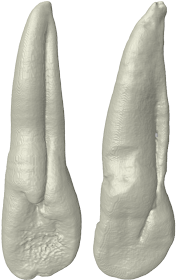Abstract
Introduction This study aimed to evaluate the frequency of dentinal microcracks observed after root canal preparation with 2 reciprocating and a conventional fullsequence rotary system using micro–computed tomographic analysis.
Methods Thirty mesial roots of mandibular molars presenting a type II Vertucci canal configuration were scanned at an isotropic resolution of 14.16 mm. The sample was randomly assigned to 3 experimental groups (n= 10) according to the system used for the root canal preparation: group A-Reciproc (VDW, Munich, Germany), group B-WaveOne (Dentsply Maillefer, Baillagues, Switzerland), and group C-BioRaCe (FKG Dentaire, La-Chaux-de-Fonds,Switzerland). Second and third scans were taken after the root canals were prepared with instruments sizes 25 and 40, respectively. Then, pre- and postoperative cross-section images of the roots (N= 65,340) were screened to identify the presence of dentinal defects.
Results Dentinal microcracks were observed in 8.72% (n= 5697), 11.01% (n= 7197), and 7.91% (n= 5169) of the cross-sections from groups A (Reciproc), B (WaveOne), and C (BioRaCe), respectively. All dentinal defects identified in the postoperative cross-sections were also observed in the corresponding preoperative images.
Conclusions No causal relationship between dentinal microcrack formation and canal preparation procedures with Reciproc, WaveOne, and BioRaCe systems was observed.







